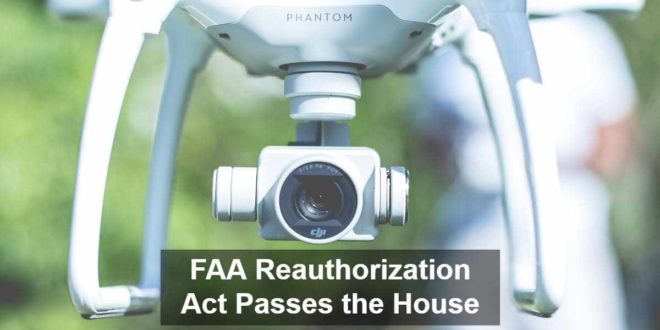On Wednesday, September 26, 2018, the House passed the FAA Reauthorization Act—a bill to authorize Federal Aviation Administration programs for five years. The House approved the measure by a 398-23 vote. To be turned into law it must be approved by the Senate and signed by the President.
The FAA’s current authority expires Sunday, but Congress could pass a brief extension to give the Senate more time to consider the House-passed bill. The House is expected to pass a short-term extension of existing authorities through October 7 in case the Senate is not able to follow suit before the September 30 deadline.
In our August FAA Reauthorization Bill update, there was a dim outlook on whether or not Congress would act on the bill before the fast approaching deadline. The House had proposed amendments to the bill, covering a range of issues, including air traffic management of unmanned aircraft, the role of state and local government in UAS regulation, and increased transparency of information on approved sUAS waivers and airspace authorizations.
Senate Approaches an Agreement on FAA Reauthorization
The outlook on Senate approval is positive, with expectations that the Senate will pass the long-term bill with strong, bipartisan support before the deadline. The Small UAV Coalition commended the bipartisan leadership of the Senate Commerce, Science and Transportation and House Transportation and Infrastructure Committees for reaching an agreement over the weekend on legislation to reauthorize the Federal Aviation Administration (FAA) for five years.
In particular, the Coalition was pleased that the legislation will:
- Expedite the development and implementation of an unmanned traffic management (UTM) system.
- Give the FAA the flexibility needed to appropriately regulate all UAS, including to impose remote identification and tracking requirements.
- Enable federal law enforcement to conduct tailored countermeasures operations with due consideration to the ongoing safety of the national airspace and privacy and civil liberties.
- Establish a process to develop consensus industry standards in lieu of protracted type and airworthiness certification.
- Improve the pathway to safely enable ubiquitous UAS delivery operations through a rigorous, risk-based certification process.
- Increase transparency in the Part 107 waiver approval process.
Once enacted into law, the federal government will have the necessary tools to lift the hold on UAS rulemakings. Congress has authorized the government to establish appropriate remote identification and tracking and countermeasure programs. This will also make it easier for the FAA to develop new regulations that enable routine expanded commercial operations, including flights over people, beyond the visual line of sight, and carrying property.
FAA Reauthorization Means Progress for UAS
Some of the most pressing issues packed within the FAA Reauthorization Act are regulations for deliveries, hobbyists, counter-UAS systems, unmanned traffic systems, and remote ID. We summarize some of the most crucial sections of the FAA Reauthorization Act pertinent to these issues below.
Drone Deliveries
In SEC. 348 of the bill, the FAA is given one year to update existing regulations to authorize the carriage of property by operators of small UAS for compensation or hire. They will have to create a certification process for UAS operators who want to carry/deliver property for compensation or hire.
Section 336 Hobbyists
Under SEC. 349 of the bill, hobbyists who previously flew under Special Rule for Model Aircraft (Section 336), will need to pass an online aeronautical knowledge and safety test. The test can be administered electronically by the FAA, a community-based organization, or a person designated by the FAA.
Counter-UAS Systems
In SEC. 364 of the bill, the FAA is asked to review agencies currently authorized to operate Counter-Unmanned Aircraft Systems (C-UAS). The review should include the process of interagency coordination of C-UAS activity and standards for operation of C-UAS. Congress has asked to examine progress on this review within four months of the passage of the bill.
Unmanned Traffic Management and Remote ID
SEC. 376 of the bill requests the FAA to compose a plan for full operational capability of UAS traffic management with NASA and UAS industry stakeholders. They shall develop a plan to allow the implementation of UTM services that expand operations beyond visual line of sight while maintaining the FAA Extension, Safety, and Security Act of 2016. This section also outlines requirements for the completion of the UTM System Pilot Program.
For more details on the FAA Reauthorization Act, read the full bill here. You can also share your thoughts on the how this bill will impact the UAS industry in this thread on our community forum.
https://uavcoach.com/house-approves-faa-reauthorization/
 Unmanned Aerial Vehicle The latest drone news
Unmanned Aerial Vehicle The latest drone news




